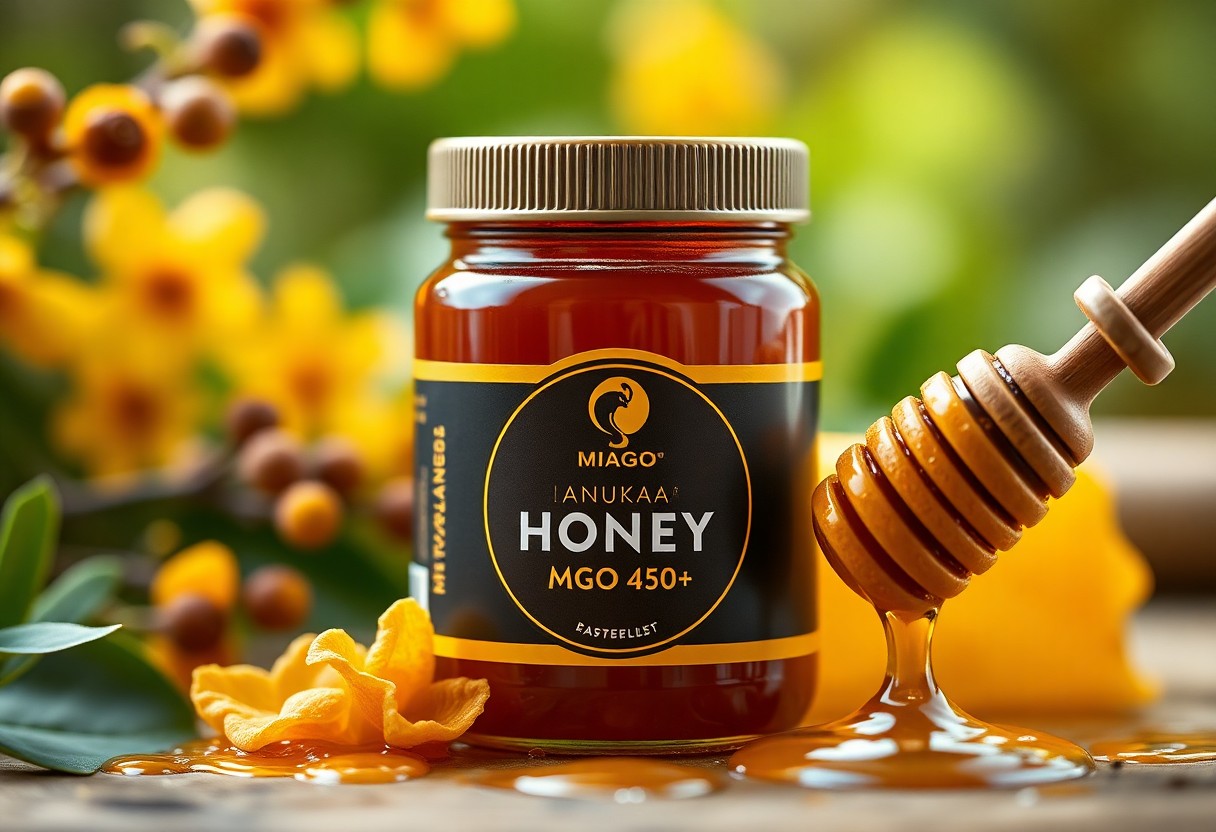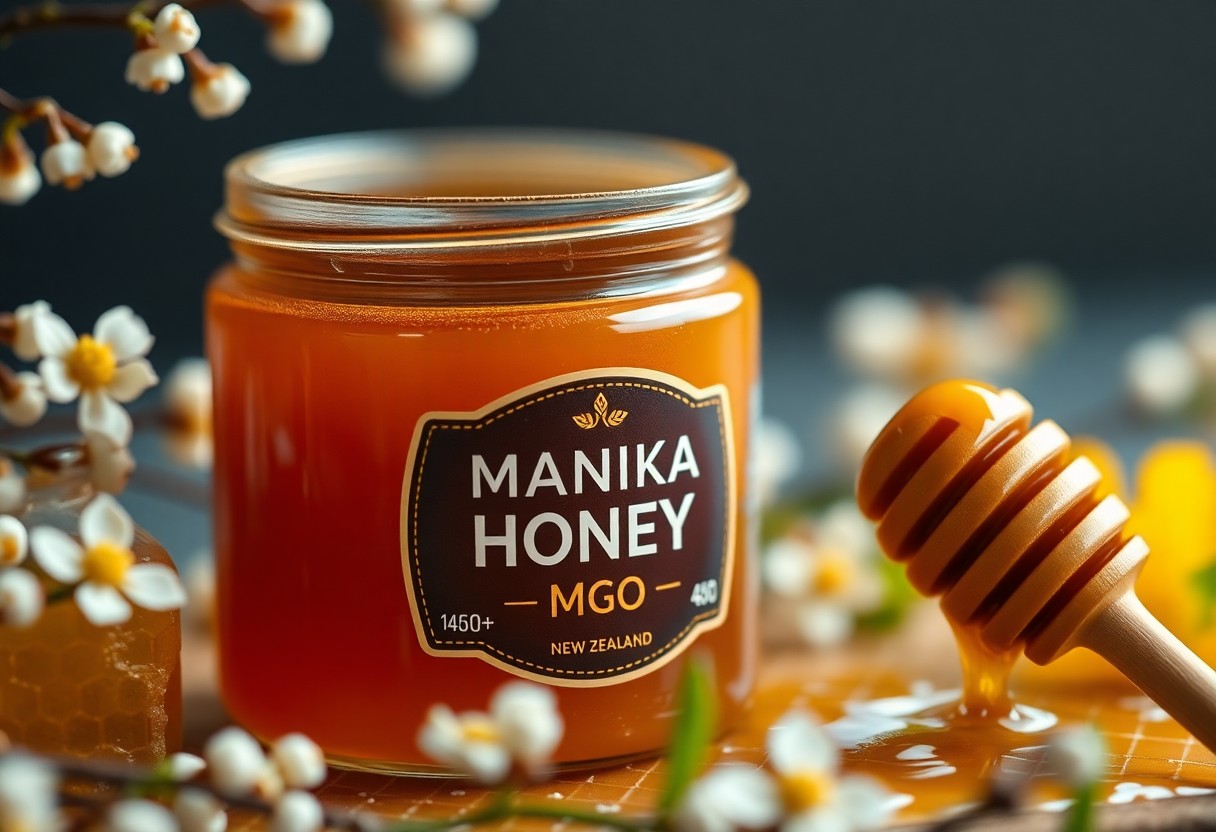There’s a growing interest in manuka honey, renowned for its unique health benefits and exceptional antibacterial properties. When purchasing this premium honey, you need to focus on the MGO rating, which indicates its potency, especially if you’re considering MGO 450+ or higher. Understanding this grading system is imperative to ensure you’re investing in a product that meets your health needs. For further insights, explore our guide to Unlocking the True Value of Mānuka Honey.
Understanding Manuka Honey
The world of honey is vast, but Manuka honey, derived from the nectar of the Manuka tree in New Zealand, stands out for its unique properties. This honey is celebrated for its potential health benefits and distinct flavor, making it a valuable addition to your wellness routine. Understanding its grading systems, such as MGO, can help you make informed choices when purchasing.
What is Manuka Honey?
To put it simply, Manuka honey is a type of honey that originates from the flowers of the Manuka tree. Its unique composition, particularly the presence of Methylglyoxal (MGO), contributes to its medicinal properties, differentiating it from regular honey. This natural sweetener not only delights the palate but also offers remarkable health benefits.
Benefits of Manuka Honey
Any discussion about Manuka honey must highlight its impressive array of benefits. It is known for its antibacterial properties, supports wound healing, and may help soothe sore throats. Additionally, its antioxidant content may play a role in promoting overall health and wellness.
In addition to its antibacterial qualities, Manuka honey is recognized for its ability to enhance digestive health and boost the immune system. Its topical application can aid in healing skin conditions and preventing infections, making it a versatile addition to your health toolkit. Considering its high content of MGO, the benefits of Manuka honey become even more pronounced the higher the rating, leading to greater overall health and healing potentials.
Decoding MGO Ratings
Assuming you’re on a quest for potent health benefits, understanding MGO ratings in Manuka honey is vital. MGO represents methylglyoxal, the active compound that gives Manuka its unique properties. As the MGO rating increases, so does the honey’s antibacterial strength, making it a sought-after choice for those seeking natural remedies. You should look for higher MGO numbers to ensure the honey you purchase delivers the best results.
What is MGO?
On a molecular level, MGO, or methylglyoxal, is the compound responsible for the distinctive antibacterial qualities of Manuka honey. It originates from dihydroxyacetone (DHA), which is predominantly found in the nectar of the Manuka flower. When bees process this nectar, DHA is converted into MGO, giving it potent therapeutic properties that set it apart from other types of honey.
Importance of MGO 450+
Decoding the significance of MGO 450+ is vital for selecting high-quality Manuka honey. MGO 450+ indicates a strong antibacterial potency, which is particularly effective for enhancing immune health and promoting wound healing. You’ll find that this potency can also aid in digestive health and provide relief from certain ailments.
Another aspect to consider is that MGO 450+ Manuka honey not only offers enhanced therapeutic benefits but can also be a more effective choice for chronic conditions. With higher MGO levels, you gain access to greater healing properties that contribute to your overall well-being. Whether you’re using it for its medicinal benefits or as a natural sweetener, MGO 450+ is a potent option that can elevate your health journey.
Factors to Consider When Buying
It’s important to consider several factors when purchasing Manuka honey. Ensure you evaluate:
- Quality ratings like MGO
- Purity and authenticity
- Packaging and labeling
- Price and value
Perceiving these elements will help you make an informed decision.
Purity and Authenticity
Against common misconceptions, not all Manuka honey is created equal. It’s vital to purchase from reputable brands that provide clear labeling and proof of authenticity to avoid counterfeit products that could compromise your health.
Origin and Certification
Purity matters when it comes to sourcing Manuka honey. Always verify the honey’s origin, as those from New Zealand and Australia are generally regarded as the most authentic. Look for certifications such as UMF (Unique Manuka Factor) or MGO ratings, as they provide assurance about the honey’s quality and active compounds.
Even seasoned buyers can be unaware that authentic Manuka honey is exclusively derived from the nectar of the Manuka tree, native to New Zealand. This honey must have a verified UMF or MGO rating to confirm its potency and therapeutic properties. Notably, fraudulent products may lack such certifications, offering limited benefits and potentially posing health risks. Always seek transparent information from trusted sources when making your purchase.

Storage and Handling Recommendations
Many people overlook the importance of proper storage and handling of Manuka honey. To maintain its unique properties and flavor, it should be stored appropriately. Keeping it in a cool, dark place, away from direct sunlight and heat sources, will help preserve its quality. Avoid refrigerating it, as this can alter its texture and consistency. Always make sure the lid is tightly sealed to prevent moisture and contaminants from affecting your honey.
How to Store Manuka Honey
After purchasing your Manuka honey, transfer it to a glass or food-grade plastic container if it’s not already in one. Store it at room temperature, ideally between 60°F and 77°F (15°C – 25°C), to ensure it remains in optimal condition. Avoid frequent temperature changes and do not expose it to humidity, as this may encourage fermentation. With proper care, you can enjoy its full benefits for longer.
Shelf Life Considerations
Against popular belief, Manuka honey has a long shelf life, typically lasting for up to two to three years if stored correctly. While it doesn’t spoil easily, its flavor and potency may diminish over time. Always check for any unusual changes in color, smell, or texture before consumption.
Even though Manuka honey is known for its natural preservation qualities, proper storage is key to maximizing its lifespan. If you notice any crystallization, this is a natural process and does not mean the honey is bad; simply warm it slightly in a water bath to return it to a liquid state. To ensure you are getting the most benefits, always consume honey before its expiration date and check for signs of spoilage, as consuming compromised honey can lead to health issues.

Common Myths and Misconceptions
All consumers looking to purchase Manuka honey often encounter various myths and misconceptions that can cloud their judgment. One pervasive myth is that all Manuka honey is the same; however, the potency can vary widely depending on the MGO rating, which reflects its antibacterial properties. Another misconception is that a higher price always guarantees better quality, which can lead to confusion and unexpected purchases. Being informed is paramount to ensure you buy authentic and effective Manuka honey.
Distinguishing Between Genuine and Fake Manuka Honey
Before you probe purchasing Manuka honey, it’s important to understand how to distinguish between genuine and fake products. Look for certifications from trusted organizations and specific labeling, including the right MGO ratings and UMF (Unique Manuka Factor) marks. Genuine Manuka honey will always provide transparency regarding its source and quality, helping you make an informed choice.
The Role of Price in Quality
Behind the allure of premium Manuka honey, you may wonder whether higher prices truly translate to better quality. Many consumers fall into the trap of believing that only the most expensive products are effective, but this is not always the case. Misconceptions surrounding price can lead you to overpay for fake or substandard honey. While price can reflect quality, it’s important to evaluate other factors like MGO rating and authenticity certifications. Buying from reputable sources ensures you receive high-quality products that genuinely offer health benefits. Don’t let price alone dictate your decision; always consider the complete picture when selecting Manuka honey.
Recommended Brands and Products
Once again, selecting quality Manuka honey requires careful consideration of brands and their offerings. When browsing through the extensive range of Manuka honey, ensure that you choose products that have been properly tested and carry the MGO rating you desire. Look for certifications like UMF or MGO for assurance, and consider reputable brands that prioritize quality sourcing and sustainability.
Top Manuka Honey Brands
The top Manuka honey brands have established themselves as leaders in quality and transparency. Brands like Comvita, Manuka Health, and Kiva are recognized for their rigorous testing and adherence to industry standards. They offer a range of MGO ratings, ensuring you can find a product that fits your needs and health goals.
Product Reviews and Ratings
At the same time, it’s important to pay attention to product reviews and ratings. Customer feedback provides valuable insights into the taste, texture, and effectiveness of various Manuka honey products. Look for consistent positive ratings, as well as mentions of whether the honey met expectations in terms of flavor and health benefits.
Another aspect to consider is how reviews often highlight specific qualities of the product. Insights will reveal if the honey has a pleasant taste or if it varies significantly from what you might expect. Additionally, some customers mention potential allergens or side effects. It’s wise to look for high ratings and detailed reviews to inform your buying decision, ensuring you choose a honey that suits your palate and health needs.
Summing up
Ultimately, when purchasing Manuka honey, you should pay close attention to the MGO rating, particularly if you’re looking for MGO 450+ or higher. This designation indicates a higher concentration of the beneficial compound methylglyoxal, ensuring you receive the maximum health benefits. Additionally, verify the honey’s origin, beekeeper certifications, and any supporting lab tests, as these factors contribute to quality and authenticity. By considering these aspects, you can make informed choices that align with your health goals and preferences.
Q: What does MGO stand for, and why is it important when choosing Manuka honey?
A: MGO stands for methylglyoxal, a compound found in significant amounts in Manuka honey that is believed to contribute to its unique antibacterial properties. The MGO rating indicates the concentration of this compound; for instance, MGO 450+ suggests a higher level of methylglyoxal compared to lower ratings. Higher MGO ratings generally imply stronger antibacterial activity, making it an important factor to consider when purchasing Manuka honey for therapeutic use or health benefits.
Q: How can I verify the authenticity of Manuka honey with an MGO rating?
A: Verifying the authenticity of Manuka honey involves checking for certifications and labels. Reputable brands often provide a UMF (Unique Manuka Factor) rating alongside the MGO content, which signifies that the honey has been independently tested for its purity and authenticity. Look for labels that state both the MGO level and the UMF rating, as this adds credibility to the product. Additionally, purchasing from well-known brands or retailers specializing in Manuka honey can further ensure you’re getting a genuine product.
Q: Are there additional factors, aside from MGO, to consider when purchasing Manuka honey?
A: Yes, beyond MGO ratings, it’s imperative to consider factors like the honey’s origin, packaging, and storage. High-quality Manuka honey is typically sourced from New Zealand, and the label should indicate its origin. Packaging should be in a dark glass jar to protect the honey from light, which can degrade its quality over time. It’s also advisable to check for any additives or fillers in the honey, as pure Manuka honey should contain no additional ingredients. Lastly, consider the production date and store the honey in a cool, dark place to preserve its beneficial properties.


